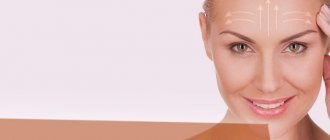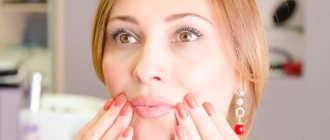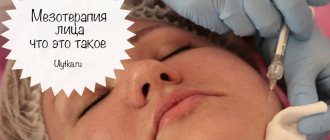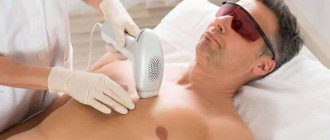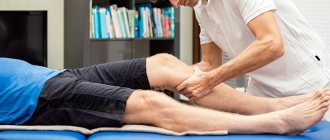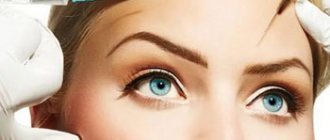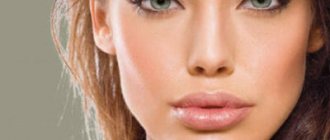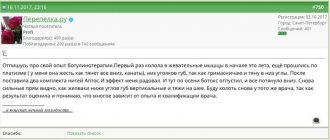The essence of the procedure
Botox injections around the eyes are considered a safe and effective alternative to plastic surgery.
The procedure is carried out to correct early signs of aging of the epidermis, improve the patient’s appearance, and can also be used to lift the upper eyelid and eyebrow.
Botulinum toxin A in this case is injected into the orbicularis oculi muscle, between the eyebrows and into the temporal angles of the orbital fissure. When the drug gets into the facial muscles, the functional activity of the nerve endings is inhibited, the impulses that should contract the muscle tissue are blocked. In this area, the skin stops moving and gathering into folds. As a result, wrinkles gradually disappear and the area around the eyes is smoothed out.
The decision to administer Botox is made by the doctor. Main indications:
- eyebrows drooped, their original shape changed due to the weakness of the surrounding tissue;
- constant swelling, bags and circles under the eyes, not associated with impaired kidney function or pathologies of other organs;
- drooping upper eyelid (ptosis);
- expression wrinkles of small and medium depth appeared around the eyes, like “crow’s feet”.
For patients aged 50+, a whole range of measures is carried out, including Botox, hardware procedures, and the use of fillers.
Buyanov Sergey Yurievich (Expert Doctor):
When the upper eyelid droops, Botox injections can only help with mild ptosis. It is impossible to eliminate a high degree of overhang using a muscle relaxant drug. Most often, it happens the other way around: after the injection of Botox, the upper eyelid droops.
Effect of Botox
Botox is the brand name of an American drug produced, as well as the procedure itself for subcutaneous or intramuscular administration. The drug is based on botulinum toxin type A, one of the strongest poisons. In small doses it is easily controlled and not dangerous to the body, and its muscle relaxant properties are successfully used in cosmetology.
The poison is extracted from microorganisms Clostridium botulinum, stabilized and purified from protein impurities. The action of the neurotoxin is based on blocking the transmission of nerve impulses. This brings the treated muscles into a state of relaxation, while the adjacent skin is smoothed. The partial paresis created by the neurotoxin is a reversible reaction. After 4–6 months, muscle activity is restored.
Main nuances of the procedure:
- Botox injections are effective only in relation to facial wrinkles formed as a result of high muscle activity;
- the substance does not act against other types of wrinkles associated with structural age-related changes in the skin;
- the result of the procedure lasts up to six months, after which muscle activity is restored again;
- During this period, the treated muscles remain inactive, and the process of formation of new folds stops.
The drug has become the standard for assessing the degree of wrinkle smoothing, and many cosmetic products “with the Botox effect” have appeared.
Advantages and disadvantages
| pros | Minuses |
|
|
Mechanism of action and scope of application
Botulinum toxin has the unique ability to block the transmission of nerve impulses to muscles. This leads to muscle relaxation, due to which facial wrinkles are smoothed out
The face becomes calm and serene , it looks much younger than before the procedure, and this effect lasts for an average of six months.
Various drugs based on botulinum toxin are used in the cosmetology market, such as Botox and Dysport , Relatox and Xeomin . But we will tell you using the example of two drugs - Botox and Dysport .
Botox . The manufacturing company is located in the USA ; the manufacturing company is Allergan . The company uses auxiliary components: sodium chloride and human plasma albumin. The cost of the drug is higher due to the high concentration of the active substance: one unit of Botox is equal to approximately three units of Dysport . Therefore, it is used more sparingly; in the end, the cost of the procedure is approximately the same.
Disport - the drug is produced in Europe by the French company Ipsen . The substance contains botulinum toxin and auxiliary substances lactose and albumin. Since the drug has a high degree of penetration into tissue, it begins to act a little faster than its analogues, although the final effect, as with Botox , is achieved within two weeks.
As a rule, injections of Botox and Dysport (these are similar drugs, the only difference is in the manufacturer and concentration of the active substance) are used to correct expression wrinkles in the upper third of the face. Botulinum toxin is also used to treat hyperhidrosis . Under the influence of the drug, sweating decreases due to a reduction in the transmission of nerve impulses to the sweat glands.
Using a very thin needle, a cosmetologist injects botulinum toxin-based preparations into the skin to an average depth of 2-3 mm .
During the day, you need to touch the treated areas with your hands as little as possible and under no circumstances massage them so that the drug is evenly distributed under the skin. During the week, you should avoid thermal procedures, active physical exercise, and alcohol abuse. Your doctor will tell you about other restrictions. In general, you can lead a normal lifestyle, the drug does not affect performance in any way and does not spoil your appearance.
What drugs are used
Twenty years ago, there was only one drug on the market containing botulinum toxin, the well-known Botox.
Now there are many analogues that allow you to achieve exactly the same result. It is important to know their list and description in order to avoid dangerous counterfeiting.
- Botox . The drug contains botulinum toxin A itself as the main component, as well as albumin and sodium chloride solution. Made in America and imported to other countries. Rarely causes an allergic reaction. A special feature of the drug is the fact that it does not spread to neighboring locations; the result lasts for 4-7 months. Possible addictive effect.
- Botulax . Manufacturer: South Korea. According to reviews from cosmetologists and patients themselves, the medicine has a large number of side effects and a shorter lasting result after use.
- Dysport . A French drug that can, to some extent, block the functioning of non-targeted muscle fibers. Due to the low concentration of the main substance, increased doses must be administered to obtain the desired effect.
- Relatox . This domestic drug, which is no different in its properties and composition from Botox, helps get rid of expression wrinkles. During insertion, a person may experience some pain, despite high-quality anesthesia. The effect lasts about 9 months.
- Xeomin . Manufacturer: Germany. The main feature is considered to be low molecular weight, due to which an allergic reaction occurs much less frequently, and discomfort also occurs much less frequently. The medication preserves normal facial expressions.
- Lantox . The most painful botulinum toxin injections imported from China. The effect of smoothing wrinkles lasts for a long time, the price for the procedure is much lower, however, the likelihood of developing hypersensitivity increases sharply.
Other Botox Options
There is a procedure called Botox lifting. To correct deformation of the facial contour and smooth out wrinkles, injections are made according to a specific pattern. The drug is administered in such a way as to block the contraction of the depressor muscles and preserve the work of their antagonists. Facial asymmetry, a consequence of neurological disorders, can also be corrected through Botox. The specialist injects from 2 to 4 units of the drug and aligns the position of the eyebrows, corners of the mouth, and eye slits.
Effective implementation of the procedure depends on the correct selection of dosage. The specialist must know the rules for diluting the drug to the required concentration and determining the exact places for injections. The indicated dosage can be adjusted by the doctor up or down according to the patient’s characteristics.
Carrying out the procedure
Botox cannot be administered at home - it is very dangerous to health and can lead to irreversible consequences.
At the initial consultation with a cosmetologist, the course of the procedure and the need for it are determined.
The doctor must know about the patient’s health status, the presence of concomitant pathologies, allergic reactions, and constant use of medications. The specialist conducts an examination and, to be on the safe side, prescribes a general and, if necessary, a biochemical blood test.
If Botox is approved for the patient, he can begin preparing:
- You must stop drinking alcohol and smoking within a week, otherwise there is a risk of edema;
- limit physical activity per day;
- 14 days in advance, stop taking vitamins, tinctures and other medications; if it is impossible to completely stop taking the medications, the issue is resolved on an individual basis.
When carrying out antibiotic therapy, the procedure is postponed 10-14 days later than the stated date.
Protocol
All manipulations should be carried out only by an experienced doctor - the skin around the eyes is thin and delicate, any incorrect movement can lead to damage to blood vessels or displacement of botulinum toxin.
Buyanov Sergey Yurievich (Expert Doctor):
In addition, around the circumference of the orbit there are exit points for the trigeminal nerve, which, if damaged by Botox, can have very unpleasant consequences. Both at the time of injection and in the next 3-6 months.
The procedure includes a certain sequence of actions:
- the patient sits comfortably in a cosmetology chair in a reclining state;
- the doctor makes marks where the product will be administered;
- If desired, anesthesia is performed - a cream with an anesthetic is applied in an even layer to the area around the eyes and after a while is removed with a cotton pad;
- Before the injection, the areas are disinfected, the ampoule, packaging with a syringe is opened in front of the patient;
- injections are carried out with an ultra-thin needle and in small doses, the whole procedure takes no more than ten minutes.
After all manipulations, the patient remains under the supervision of a cosmetologist, as there is a possibility of developing an immediate allergic reaction in the form of swelling, rash, and severe redness.
Course duration
To maintain the results obtained, Botox around the eyes must be used every 4-8 months, the timing depends on the individual characteristics of the body, age and condition of the skin.
With each correction, the duration of the drug’s effect increases, the woman herself loses the habit of squinting, the effect subsequently lasts about 8-10 months.
Determining the amount of Botox dose required
The average way to calculate the permissible amount of the drug for the entire person is to calculate by age. The total number of years of the patient provides a guideline for total dosage. For example, a 40-year-old woman will need about 40 injections. Each area of the face has several points for administering the drug. Typically, Botox is distributed evenly on both sides of the face. The largest portion falls on the eye and forehead area. Approximate dosage of Botox for all areas of the face and neck:
- How many units of Botox do you need on your forehead? Deep wrinkles in the forehead area will require multiple Botox injections. To accurately identify wrinkles, you will need to frown your forehead. On average, the administered portion ranges from 10 to 30 units.
- How many units of Botox do you need between the eyebrows? This is one of the most noticeable wrinkles, the so-called “proud muscle”. Eliminating them will require from 10 to 25 units. Over time, eyebrows begin to hang over the eyes, giving a stern look to the face. You can lift them by giving Botox injections in a dose of 2 to 5 units.
- How many units of Botox do you need on your eyes? For each side of the face, to eliminate crow's feet, you will need from 5 to 15 units. You can inject several units of the drug under the eyes to relieve signs of fatigue.
- The amount of the drug to lift the corners of the lips is from 5 to 6 units. The substance helps to correct their shape, but does not add volume. You can increase the size of your lips using an additional procedure for introducing fillers with hyaluronic acid. Botox also smoothes purse-string wrinkles that form around the lips, characteristic of smokers.
- To get rid of “rabbit” wrinkles on the nose and bridge of the nose, you will need from 5 to 10 units of the drug.
- Nasolabial folds are folds caused by gravity. They become especially noticeable after the age of 40. To relax the muscles you will need about 6 units of Botox. Filling the folds will require the use of hyaluronic acid filler.
- You can smooth out wrinkles in the chin area by injecting from 2 to 6 units. The jaw contour is smoothed out after a dose of 40-60 units of the drug.
- To rejuvenate the front and sides of the neck, you will need from 25 to 50 units.
With the help of Botox, you can correct the oval of the face, deformed as a result of bruxism. Hypertonicity of the jaw muscles leads to an increase in the volume of the jaw, it acquires a square outline. In addition, the drug is used to combat hyperhidrosis. Relief from sweating occurs after administering up to 50 units of the substance to each armpit.
The maximum dose of the drug per procedure is no more than 250 units. The dosage calculated in relation to Botox may not correspond to its analogues. The concentration of botulinum toxin in generics differs from the original, so each drug has its own measurement of units. An incorrectly calculated dose leads to unpleasant consequences. A smaller amount of the drug does not produce results. An excess of the substance leads to too much muscle relaxation, up to temporary paralysis, turning the face into a mask.
Healing period
The healing period is 3-10 days, so the result after the procedure can be fully assessed only after two weeks. A small hematoma, swelling, discomfort or pain may occur in the area where botulinum toxin is injected.
All symptoms should go away on their own without additional intervention. If they persist and compactions occur. You must immediately consult a doctor for examination and treatment.
During the recovery period, there is a whole list of restrictions that allow you to achieve the best result:
- in the first 6-8 hours you do not need to bend over or lie on the bed or sofa;
- on the first day it is forbidden to wash your face, touch the area where botulinum toxin was injected with your hands, or carry out any procedures;
- for 14 days you should refuse to visit the solarium, beach, bathhouse or sauna;
- for two weeks, reduce the amount of tea, coffee, hot and spicy foods consumed;
- during the same period, do not drink alcoholic beverages;
- sleep only on your back, it is advisable to choose an orthopedic pillow to avoid facial asymmetry.
When applying decorative and skincare cosmetics, you must speak with your doctor individually.
Indications and contraindications
Injections of botulinum toxin into the area of the superciliary arches are carried out in the presence of the following indications:
- age-related changes on the surface of the skin;
- drooping eyelid on one side of the eye, congenital or acquired;
- the presence of pronounced folds between the eyebrows;
- desire to change the existing contour of the brow ridges;
- forehead skin folds;
- raising the eyebrow line, lowered over the years;
- correction of asymmetry;
- correction of changes resulting from any disease or injury;
- correction of facial wrinkles;
- getting rid of a gloomy facial expression.
Botulinum therapy is an invasive medical procedure, so it is not possible for all people.
Contraindications to Botox injections:
- oncological diseases;
- epilepsy;
- disturbances in the rate of blood clotting;
- infectious diseases of the skin;
- allergic reactions;
- use of certain medications;
- individual intolerance to the components of the drug used;
- period of pregnancy or breastfeeding.
You cannot hide from the cosmetologist the presence of certain contraindications to the procedure, otherwise, health risks increase and serious complications may occur.
Precautionary measures
Working with botulinum toxin requires compliance with safety rules. The popularity of the cosmetic procedure has led to the emergence of pseudo-specialists, negligence, and an increase in the number of counterfeit drugs.
To reduce the risk of complications, you must:
- choose a salon or cosmetology clinic that has been providing a similar service for more than five years;
- see customer reviews;
- study in detail the qualifications of the specialist, clarify the availability of higher education, since only a doctor can perform injections;
- check the license, certificates confirming the quality of botulinum toxin;
- pay attention to the fact that the doctor is obliged to open the ampoule in the presence of the patient and use disposable instruments.
In addition, during all manipulations the rules of asepsis and antiseptics must be observed.
Side effects
Botulinum toxin is a serious and dangerous substance in high doses. It is possible that an undesirable reaction may develop in the form of:
- headache;
- displacement of the introduced component with the formation of folds;
- the appearance of creases under the lower eyelids or on the forehead;
- dry skin;
- allergies;
- tearfulness;
- formation of seals in the area of drug administration;
- drooping eyelids;
- swelling of tissues;
- formation of hematomas;
- lymphostasis;
- facial asymmetry.
Edema can occur for many reasons, they are mainly caused by kidney and liver diseases, ignoring medical recommendations, and violating the rules for administering the substance.
If symptoms persist for 10 days or more, you should contact a cosmetologist for advice and further treatment.
Contraindications
Smoothing wrinkles using this method is not indicated for all patients. The list of contraindications includes:
- acute and chronic diseases in the acute stage;
- pregnancy;
- lactation period;
- menstruation;
- increase in body temperature due to local or systemic inflammation;
- skin diseases;
- functional disorders of the nervous, endocrine, and cardiovascular systems in the stage of decompensation;
- risk of developing an allergic reaction;
- period after surgery;
- individual intolerance to the drug.
It is not advisable to combine the procedure with taking hormonal medications, anticoagulants and antiplatelet agents, or with alcoholic beverages.
How many units of Botox should you use on your face?
Before talking about a certain number of units of a substance for one or another part of the face, it is worth knowing that only an experienced cosmetologist will be able to establish the exact number of units based on the condition of the patient’s facial skin. Of course, there is an average of the units used, but still only a doctor can do everything at the highest professional level.
If less Botox is used, the effect will be very insignificant. If you inject more units of the substance, your face will look like a mask. Therefore, trust your face exclusively to professionals in their field.
Opinion of cosmetologists
On thematic websites and forums where professionals communicate, there are many comments regarding the injection of botulinum toxin into various areas of the body, including around the eyes. They look like this:
Eyebrows raised a lot after Botox
After a Botox procedure, there is a possibility that the crease that needed to be corrected remains in place. Sometimes the eyebrows go up or down. Such situations may arise due to insufficient qualifications of the specialist who performed the procedure, improper care during the recovery period, and individual characteristics of the resorption of the drug inside the body.
A strong raising of the eyebrows after the procedure may be due to the administration of too large a dose of the drug. To return the arches to their place, the introduction of an antagonist agent is indicated.
Mephistopheles eyebrows
A complication such as “Mephistopheles eyebrows” can occur due to incorrectly chosen proportions of dilution of the drug.
- If not enough substance is taken, the muscles may not be sufficiently blocked.
- A large amount of the substance will lead to severe muscle tightness, complete blocking of the muscles.
- Excessive dosage causes the “Mephistopheles” effect.
What to do if such a problem occurs? You can wait until the drug is partially absorbed, and the situation will correct itself. However, if a woman’s appearance leaves much to be desired, it is recommended to contact the specialist who performed the treatment. As a rule, he injects botulinum toxin antagonist drugs, which relaxes the overstressed muscle.
Symptoms
Neuralgia is a disease that appears as a result of compression of the nerve ending or the entire nerve trunk, which leads to severe pain in the muscles located in close proximity to the inflamed area. There are several types of neuralgia, the symptoms of which depend on which part of the body the inflammation is located in:
- trigeminal nerve. The most common type of disease, which is characterized by itchy skin and the appearance of goosebumps in the facial area. Appears as a result of facial injuries, due to diseased teeth, and inflamed sinuses. An attack can occur unexpectedly and last for several minutes when touching the face, brushing teeth, or exposure to bright light. Eating food that is too cold or hot has a particularly strong effect, sometimes pain occurs from sharp sounds;
- intercostal The main cause of this type of neuralgia is osteochondrosis of the thoracic spine. Ossification of the intervertebral discs leads to pinched nerves and causes acute pain in the chest area;
- external cutaneous nerve of the thigh. A burning sensation and numbness appear in the corresponding area, which becomes stronger during physical activity;
- pterygopalatine node. It is characterized by severe pain in the palate, eyes, and eyelids. Attacks are usually quite long and can last from several hours to three weeks. The main time for attacks to occur is at night. This type of neuralgia is characterized by one of the longest periods of pain;
- glossopharyngeal nerve. A rare type of disease. Pain first appears in the throat, which then spreads to the ear and lower jaw. Often has a dull, aching character;
- occipital nerve. A rather dangerous type of neuralgia, the symptoms of which are a dull pain in the back of the head, gradually moving to the temples, eyes and ears. Because the nerve is located close to the brain, symptoms may be similar to a concussion - nausea and vomiting while moving.
A nervous tic is a sudden and sharp muscle movement that is intermittent. This disease can be primary (appears in childhood after severe psychological trauma and is successfully treated), secondary (occurs as a result of cerebrovascular accident, after encephalitis tick bites) and hereditary. The latter type is called Tourette's syndrome and can be characterized by both simple nervous tics and shouting obscene words or demonstrating obscene gestures.
A tic can manifest itself in a variety of ways - it can be detected as simple twitching, affecting a limited number of muscles, or complex - causing a complex and complex movement.
In addition to muscle tics, there are also vocal tics. They are characterized by the manifestation of various vocal sounds, repetition of words after the interlocutor and are formed as a result of compression of the vocal muscles. It can also be grunting, coughing, grunting.
Diagnostic and treatment methods
To diagnose a nervous tic, the following methods are used:
- Computed tomography and MRI. These methods help identify affected areas of the brain.
- Electroencephalography. Used to identify foci of pathological activity.
During the examination, it is also necessary to visit a traumatologist and oncologist to determine a more accurate picture of the disease and exclude other possible diseases. An examination by a psychiatrist is also mandatory. In the early stages in childhood, a general and biochemical blood test is taken to make sure there are no inflammatory processes in the body.
The choice of method for diagnosing neuralgia depends on the location of the diseased nerve. As a rule, examination is used using:
- ultrasound;
- x-ray;
- MRI or CT;
- myelography.
The most difficult thing to determine is intercostal neuralgia - in this case, it is necessary to conduct complex studies of the condition of the intervertebral discs. In addition, these methods are aimed at eliminating the possibility of the presence of tumors and cysts that would compress the nerve endings. To make a diagnosis of neuralgia, doctors also need to exclude a violation of local circulation at the site of pain, which can cause the same symptoms as neuralgia.
The method of contrast discography is often used to obtain a clearer picture of the condition of the cartilage tissues of the spine. The choice of method is made by the attending physician, taking into account the patient’s existing contraindications.
Products for cooking
To prepare homemade face masks, fruits and herbs with the addition of fats and honey are most often used. The result is quite appetizing mixtures that perfectly nourish, soothe and heal the skin.
Attention! To avoid extensive allergic reactions, it is recommended to test all masks on the wrist. If 10 minutes after applying the mixture there is no redness on the skin, then the mask is suitable for use on the face.
From avocado
The exotic fruit pulp
perfectly moisturize the skin, relieve inflammation, slow down the aging process and normalize collagen production Avocado perfectly cares for sensitive skin without causing allergic reactions. To prepare an avocado mask, use a ripe fruit, the pulp of which is easily mashed with a fork into a juicy puree.
In addition to the fact that it can be used in its pure form for applications to problem areas, this pulp is mixed with other ingredients:
- Mix 1 tablespoon of avocado and banana pulp with 1 egg yolk and 1 teaspoon of honey.
- Mix 1 tablespoon of avocado puree with a teaspoon of olive oil.
The mask is applied in a thick layer and left for 10-15 minutes. Then wash off with warm water.
With aloe juice and pulp
Even healthy facial skin of any type needs periodic nutrition with aloe juice. This plant has healing properties that slow down the aging process, cleanse the skin and prevent the development of bacteria on its surface.
But there is one secret behind the use of aloe leaves. The cut leaves are washed, wrapped in a napkin and left in the refrigerator for 2 weeks. After this time, they are used for cosmetic purposes:
- Mix 2 tablespoons of aloe juice with 1 tablespoon of olive or sesame oil;
- Mix 2 tablespoons of crushed aloe leaves with the same amount of fresh cucumber pulp.
After application, leave the mask for 20-25 minutes and wash off with warm water. The result is refreshed, elastic skin. The oil in the mask moisturizes well, and the cucumber whitens.
Honey for delicate skin
Masks for wrinkles around the eyes based on honey deeply moisturize the skin and free it from impurities . But at the same time, bee products are strong allergens. Therefore, before applying honey masks to your face, you should test them on your wrist.
If the skin is not red after 10 minutes, then the mixture is safe to use:
- Add the same amount of olive oil and sour cream to a tablespoon of honey.
- Mix a tablespoon of honey with 1 egg yolk.
The masks are applied in a thick layer and left to absorb for 20 minutes.
Important! All masks for skin care around the eyes are applied from the outer corner of the eye to the inner along the lower eyelid and from the inner to the outer along the upper eyelid. This will prevent damage to thin skin.
From banana
The pulp of overripe bananas, together with other ingredients, will moisturize sensitive skin and gently lighten it . These masks are easy to prepare:
- Mix 2 tablespoons of banana puree with 1 egg yolk and a teaspoon of milk.
- Mix 2 tablespoons of crushed banana pulp with honey and sour cream in an amount of 1 tablespoon each.
Leave the banana mask on your face for 20 minutes and wash off with warm water.
Teahouse
Everyone is familiar with the way to eliminate dark circles under the eyes, when you just need to apply wet tea bags to them. But using tea leaves you can prepare truly useful masks:
- Mix a tablespoon of strong black tea with 2 teaspoons of honey.
- Mix brewed green tea leaves with sour cream, 1 tablespoon each.
Such mixtures will be a real salvation for aging skin around the eyes. Applications are kept for 15 minutes, after which they are washed.
Reference! To wash off masks, you can use decoctions of your favorite herbs instead of water. Chamomile, string, and calendula are perfect.



